An American Camino
Does a Camino de Santiago exist in North America?
The Camino de Santiago is awesome.
Walking a Camino is like doing a long string of pleasant day hikes, each ending with a warm meal, cold drink, and real bed—without breaking the bank.
When people talk about the Camino, they’re usually referring to the Camino Francés. But there are many Caminos through Spain (and neighboring Portugal and France), all of which end in the city of Santiago de Compostela.
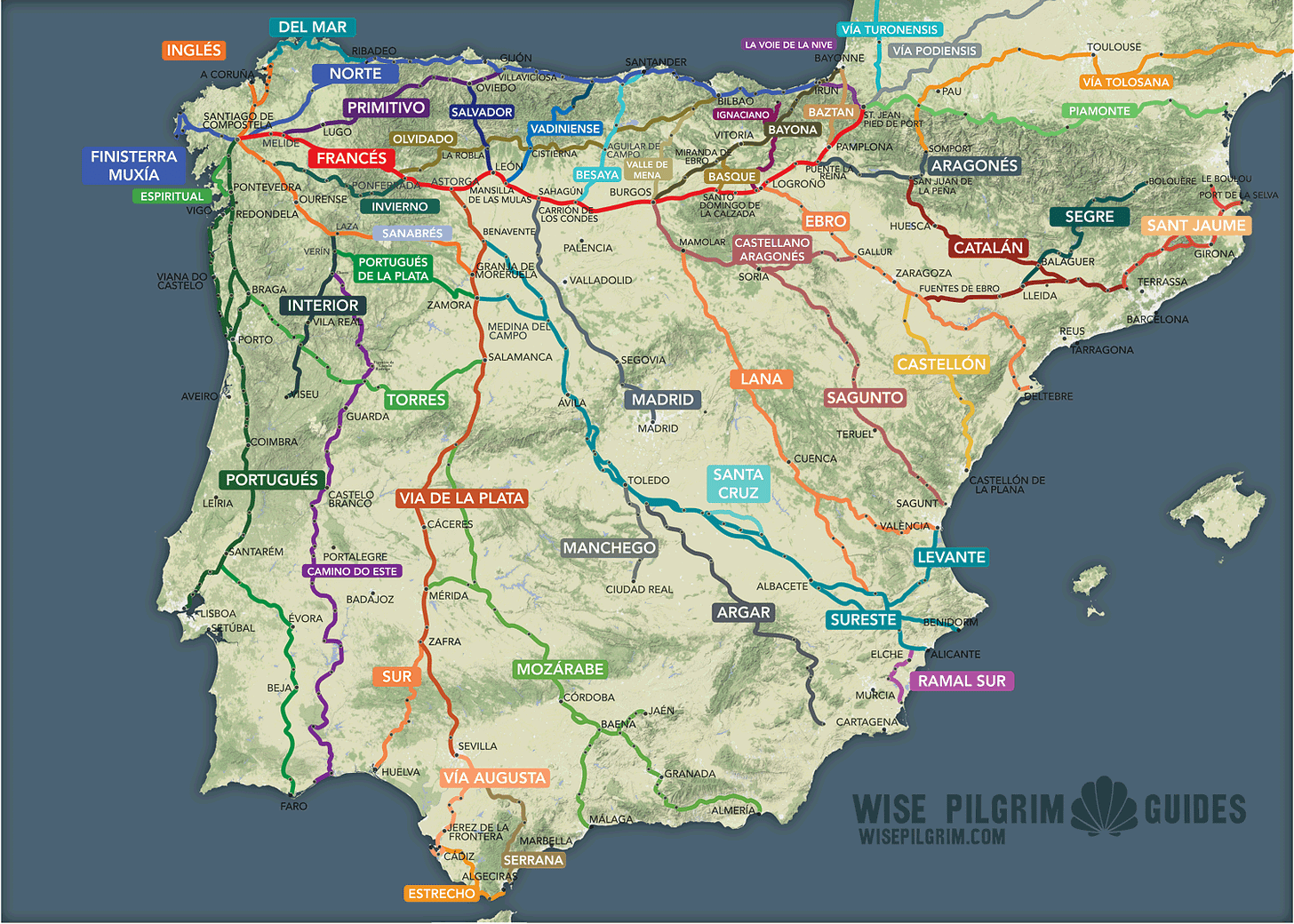
Just seven Caminos are popularly traveled, but all share these features:
frequent accommodation: no need for camping
affordable accommodation: €10-€50/night, depending on whether you’re staying in a public albergue (hiker dorm) or a private pension (basic hotel)
frequent restaurants, cafes, grocery stores, and drinking water: the most you’ll need to carry is a sack lunch, some snacks, and 1-2 liters of water
safe walking away from busy roads: it’s mostly pleasant rural roads, gravel roads, and nature paths, while never straying too far from a bus route or ambulance access point
an endless string of charming towns with deep history: cobblestone and cathedrals and countryside, oh my!
good signage: a small army of yellow arrows make it hard to get lost
Caminos, like all long walks, are excellent opportunities for reflection. What began as Christian pilgrimage routes now serve as secular or quasi-spiritual “active vacations” for soul-seekers from around the world.
The community is a big draw, too. Like the spontaneous “tramilies” (trail families) of the Pacific Crest and Appalachian Trails, clusters of like-minded and similarly-paced walkers form on the Caminos, resulting in shared meals, deep discussions, emotional support, and the occasional lifelong friend.
In 2017, I spent three weeks walking the Camino del Norte and Camino Primitivo. In 2022, I cycled the Camino Portugués and Camino Francés (occasionally in a shark costume). And in January 2026, I’ll walk the Camino-style Fisherman’s Trail in Portugal, perhaps followed by a lesser-known Camino through southern Spain.
Clearly, I’m a fan. And I can’t help but wonder: Do we have Caminos in North America? Can we have them?
The United States and Canada have incredible networks of long-distance wilderness paths, but they all require camping. Not everyone can camp, and some prefer not to. Camino-style routes bring together people of more ages, abilities, and incomes. The combination of low pack weight and frequent amenities makes multiple styles of travel possible. On a Camino, for example, I have the option to take my laptop. I can even have some nice town clothes—and gosh, regular showers—while still hiking every day! Crazytown.
The question of American Caminos feels especially pertinent because I’m getting kicked out of Europe in April 2026 (when my 2-year residency permit expires), and I already feel ruined by Europe’s endless array of accessible long-distance walking and cycling opportunities.
I need something to aspire to. Come on, America—whattaya got?
As long as North Americans have walked the Camino de Santiago, they’ve wondered whether something similar can exist back home. So I started with an online deep-dive to see what routes others have considered (or created), and then I presented my findings to three illustrious adventurers who have thought and written extensively on this topic (and each walked a hell of a lot more than me):
Tim Mathis: author of The Camino for the Rest of Us, The Dirtbag’s Guide to Life, and a forthcoming book about American pilgrimage routes.
Dave Whitson: author of Pilgrimage, multiple Camino guidebooks, and a forthcoming book about his walk across America.
David Six: Triple Crown section hiker, currently walking across Oregon.
With their feedback, I began outlining the contours of the elusive American Camino.
But first, some disclaimers. There are a few good and obvious reasons that American Caminos are harder to find (or create) than those in Europe:
In America, the distances are bigger. Towns are spread out, population density is lower, and car culture dominates.
America lacks deep history. Specifically, we lack the tradition of churches and monasteries offering cheap accommodation to Christian pilgrims: the same institutions that evolved into modern-day hiker albergues charging €10/night.
America is expensive. The Spanish Caminos are only “affordable” from the perspective of a Canadian, German, or Australian coming from a country of relative affluence. When you hike in your own country, food and housing suddenly becomes pricier. We also have many fewer youth hostels (another tradition with roots in Europe).
Life on the road in America—and I’m talking more about the U.S. than Canada now—is just a bit harsher. Compared to Europe, you’re more likely to get hit by a car, assaulted in public, or accosted by someone struggling with drug addiction. We are a land of extreme diversity, which increases the potential risks for a long walk through public spaces.
With those facts in mind, here are a few routes that emerge as contenders for an American Camino.
Certain stretches of the Appalachian Trail (East Coast)
As David Six told me, when you hike on the Appalachian Trail between New Jersey and southern Vermont, you pass through towns once or twice a day, many with affordable, hiker-oriented accommodation. Route-finding on the Appalachian Trail is straightforward, and since the trail is incredibly popular in the summer months, finding community is easy.
But the Appalachian Trail is still fundamentally a wilderness trail, and you need to be ready for a surprise night out on the longer stretches (e.g., due to injury or poor conditions). The AT is also famous for its brutal elevation change. All this increases the gear, experience, and stamina requirements, thereby decreasing Camino-style accessibility.
The California Missions Trail (West Coast)
Unbeknownst to my California-bred self, the California Missions Trail (map) is a 800-mile walking & cycling route connecting the 21 Catholic Missions between San Diego and Sonoma. It’s very much under construction, and the distances seem better suited to cycling. But at least one Camino-inspired couple documented their full journey, two walking guidebooks are available, and more stories exist on the American Pilgrims on the Camino Facebook group.
The Missions Trail connects an interesting mish-mash of urban and rural California. I can only imagine the cost of paying for food and accommodation through these parts of America. (I hope you have $5k+ burning a hole in your pocket!) But this route is a fine contender for the dirtbag pilgrimage approach, which I discuss later.
The C&O Canal Towpath (East Coast)
As Dave Whitson, Tim Mathis, and many people online told me, the “C&O” is a dirt and stone path that runs 185 miles along an old canal between Washington, DC and Cumberland, Maryland. You can walk or bike it, there are plenty of amenities, and it seems virtually impossible to get lost. A bit short and seemingly repetitive for my taste, but it has history, and it’s popular enough to make friends along the way. (The trail continues to Pittsburgh on the Great Allegheny Passage, but that stretch seems better suited to cyclists.)
The Bay Area Ridge Trail (West Coast) & other urban thru-hikes
Back in 2023, I schemed and then actually did a 2-week, 250-mile hike around the San Francisco Bay Area. It was a hell of an adventure, ping-ponging between dense urbanity and surprisingly “out there” parks and preserves. I did camp a few nights, but more out of choice than necessity. There’s good signage, frequent food, and endless pricey accommodation (I mostly stayed with friends). And while I encountered plenty of other walkers, they were all day hikers.
In a similar vein, Liz “Snorkel” Thomas is developing and promoting “urban thru-hikes.” According to Outside magazine, Snorkel has hiked “60 miles through Chicago, 200 miles in Seattle, and 210 miles in Portland, Oregon . . . [and] 54 miles from Selma to Montgomery, Alabama, on the 50th anniversary of that historic civil rights march.” She also hiked 225 miles through New York City to visit 100 city parks. (Thanks for the lead, Tim!)
Whether you’re following an established route in/around/across a metropolitan area—or you’re making one up yourself—urban hiking offers a cool, Camino-style walking opportunity. Housing won’t necessarily be affordable, you’ll need to traverse some busy roads and ugly parts of town, and you won’t have any hiking partners except the ones you bring along—but you’re guaranteed an adventure.
Short religious pilgrimage walks
David Six brought my attention to the Easter Pilgrimage to Chimayó, a walk from Albuquerque to the Santuario de Chimayó near Santa Fe, New Mexico. Apparently, some people get really serious about this walk—for example, by dragging a large cross. There’s also The Way of Stella Maris in Nova Scotia, Canada, also around 70 miles and created in 2019 with the intention to mimic the Camino de Santiago. Both of these pilgrimage walks are highly organized, date specific, and quite short. It’s cool that they exist—and their brevity and actual religiosity turn me off. Give me something longer and more agnostic, please!
The Prince Edward Island Walk (Eastern Canada)
Another Camino-inspired Canadian creation, the Island Walk traverses 430 miles of non-technical terrain around Prince Edward Island. Certain stretches don’t have accommodation, so you need to get a ride or shuttle to your lodging (also true for The California Missions Trail). Beyond this fact (and the high cost of lodging), the Island Walk might be the best contender in North America. Bravo, Canada.
“We have a Camino in America, and it’s called bicycle touring.”
Apparently Tim Mathis and David Six have a longstanding debate on this topic. David firmly believes that bicycle touring is the most reasonable way to do something like a Camino in North America. Pedaling lets you cover more distance, find accommodation each night, and stay close to roads with amenities and emergency services. It’s not walking, but it’s the best our continent has to offer.
When I cycled a section of the Transamerica Trail in summer 2022, I liked the vibe. Lots of people of all ages were doing it. Cheap or free accommodation was frequently available for long-distance cyclists, including churches, fire stations, and community centers. In the empty stretches of Wyoming and eastern Oregon, camping gear is helpful but not mandatory.
I don’t want to give up on walking, but I’m inclined to believe David. And I’m inspired when I see someone envisioning the marriage of cycle touring and Camino principles (thanks Dave!).
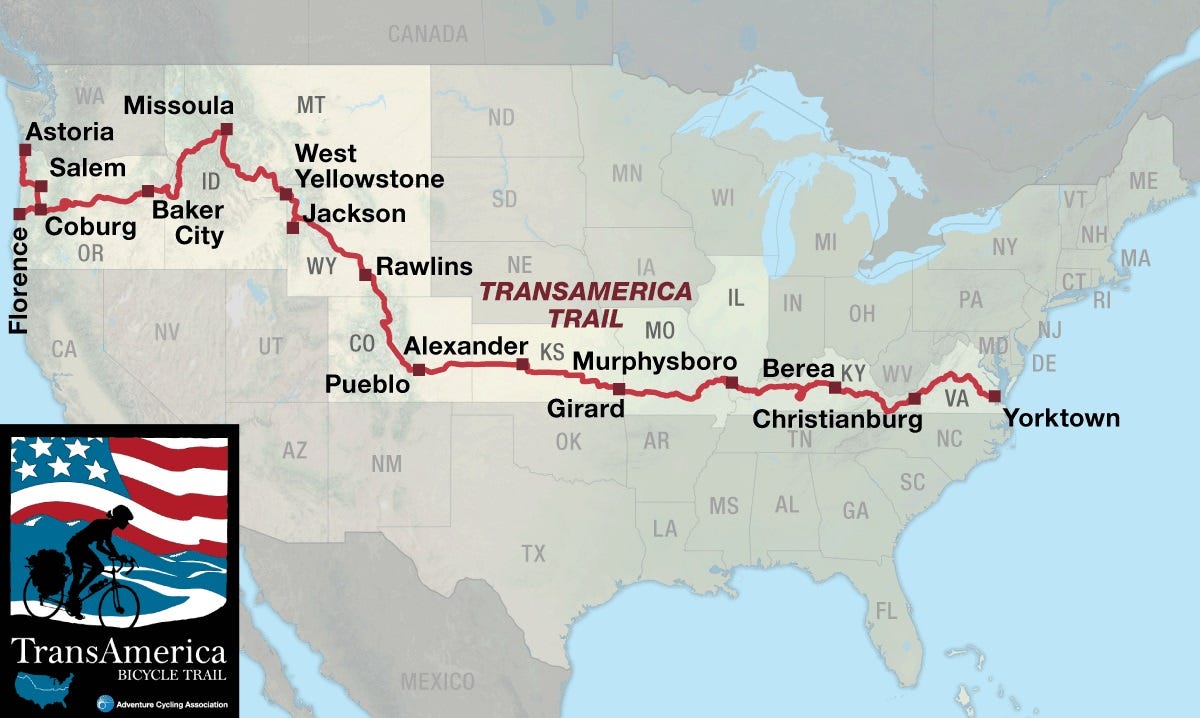
The dirtbag pilgrim approach
Finally, inspired by two 19-year-old German cyclists I met (and interviewed) at a Couchsurfing host in the south of France, I propose that almost any long voyage can approach Camino status—if you’re willing to knock on doors.
When I met Lilli and Elena, they had already cycled across Germany, spending just €10/day on food, and sleeping with a mixture of campgrounds (cheap), Couchsurfing (free), and knocking on people’s doors and asking to camp in their yard (free). This final approach often won them a meal, a couch, or even a guest room.
Yes, yes—if you’re a pair of spunky, charming, and street-smart young women traveling through your (quite safe) home country, this approach might work. It’s not for most. But that’s where hospitality networks (like Couchsurfing and Warmshowers) come in: they’re the digital equivalent of knocking on someone’s door, with the important addition of a reference system for safety.
Using this “dirtbag pilgrim” approach, you could walk across many parts of America—including quite expensive areas, like Coastal California—and not break the bank. Nor must you constantly seek new hosts, as your previous hosts are likely to know (and refer you to) other folks along your route.
What’s most important for succeeding with this approach—beyond not looking and smelling like a complete dirtbag—is having a good, true, and compelling story to offer. Why are you walking this route? What is your purpose? What’s your situation? If you can say something like, “I’m a recent college graduate trying to reconnect with my Catholic upbringing by walking to all the California Missions, and here’s my blog/Instagram showing that I’m not an axe-murderer,” you’ll have an excellent chance of getting hosted, and probably fed, most nights of your trip. Peace Pilgrim took a similar approach for 28 years.
And this is the true spirit of pilgrimage, is it not? Many of the Spanish Caminos are now developed to the point of feeling like Disneyland, especially in final 100km to Santiago de Compostela. Knocking on doors, banking on the hospitality of strangers, entering people’s homes and friend networks: this is closer to what (I imagine) the O.G. pilgrims experienced. We all want a warm meal and comfortable place to sleep at night. The farther we walk, and the more risks we take, and the more connections we make along the way, the richer these things are. That’s why Caminos matter in the first place.
So, is there an American Camino?
Not really. Or… not yet.
But we do have compelling alternatives, most notably cycle touring. And if you’re willing to camp a little, knock on a few doors, and feel more “out there,” then a world of walking adventures awaits you.
See you on the road,
🏞️ Blake


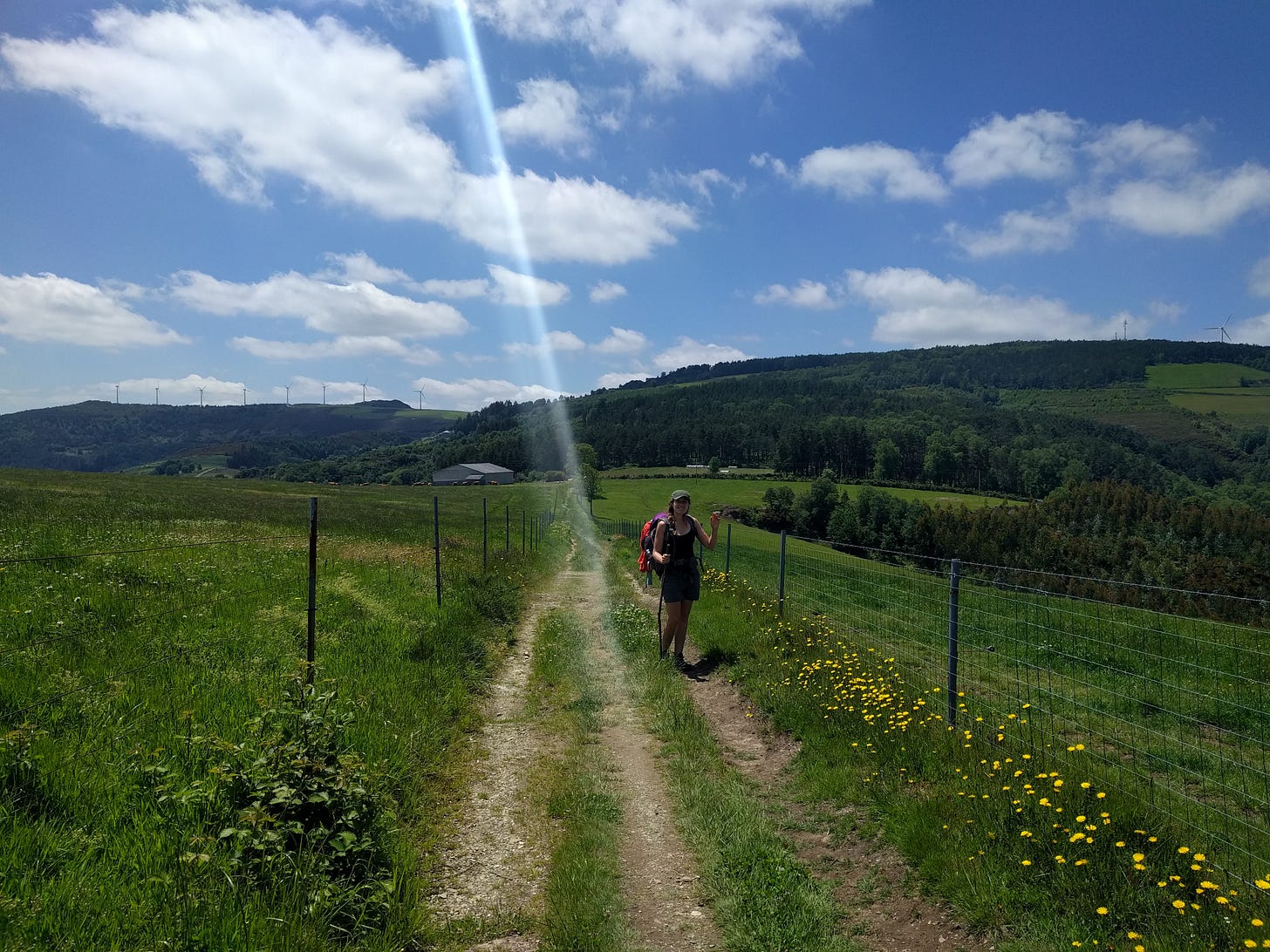

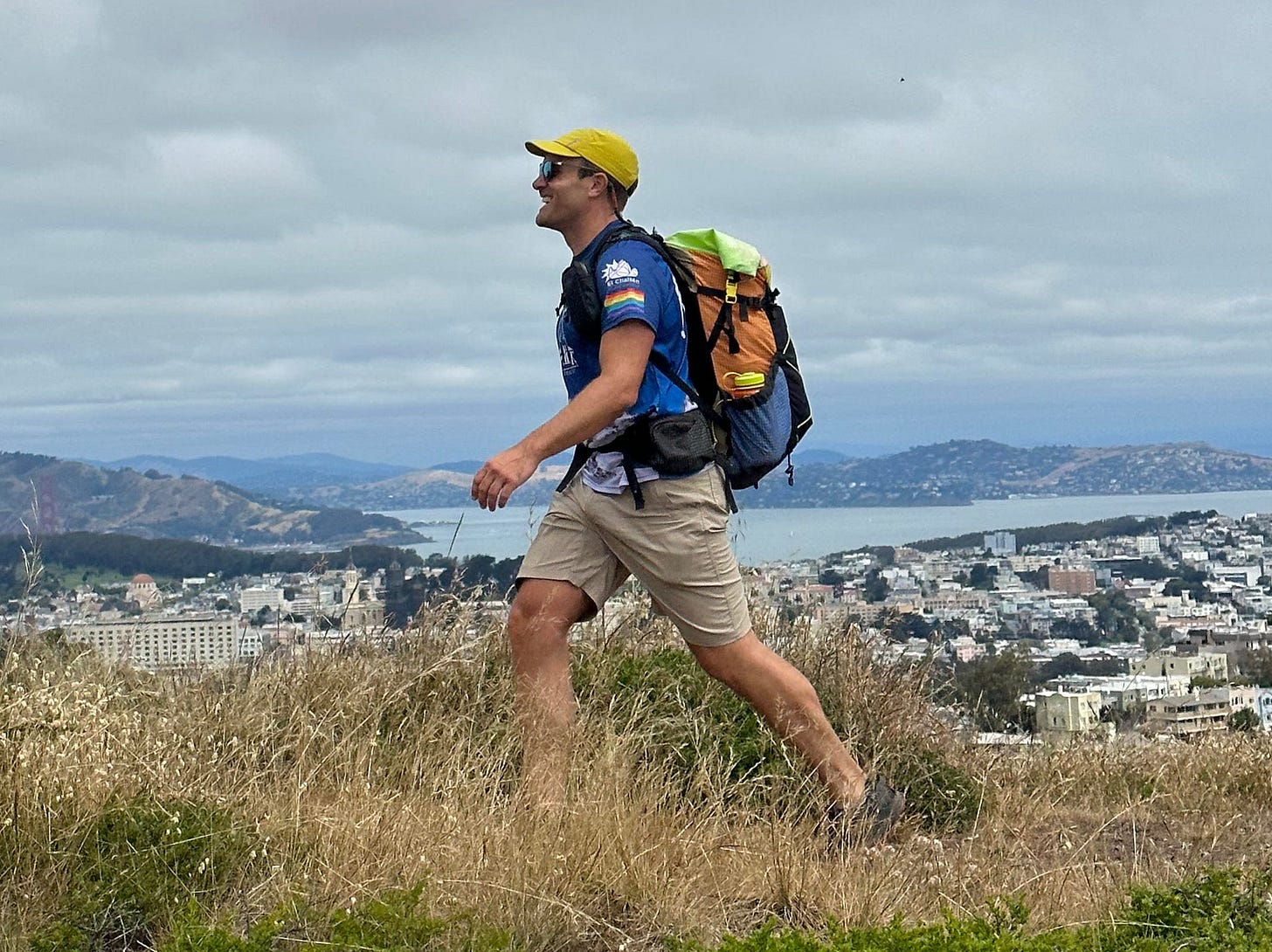
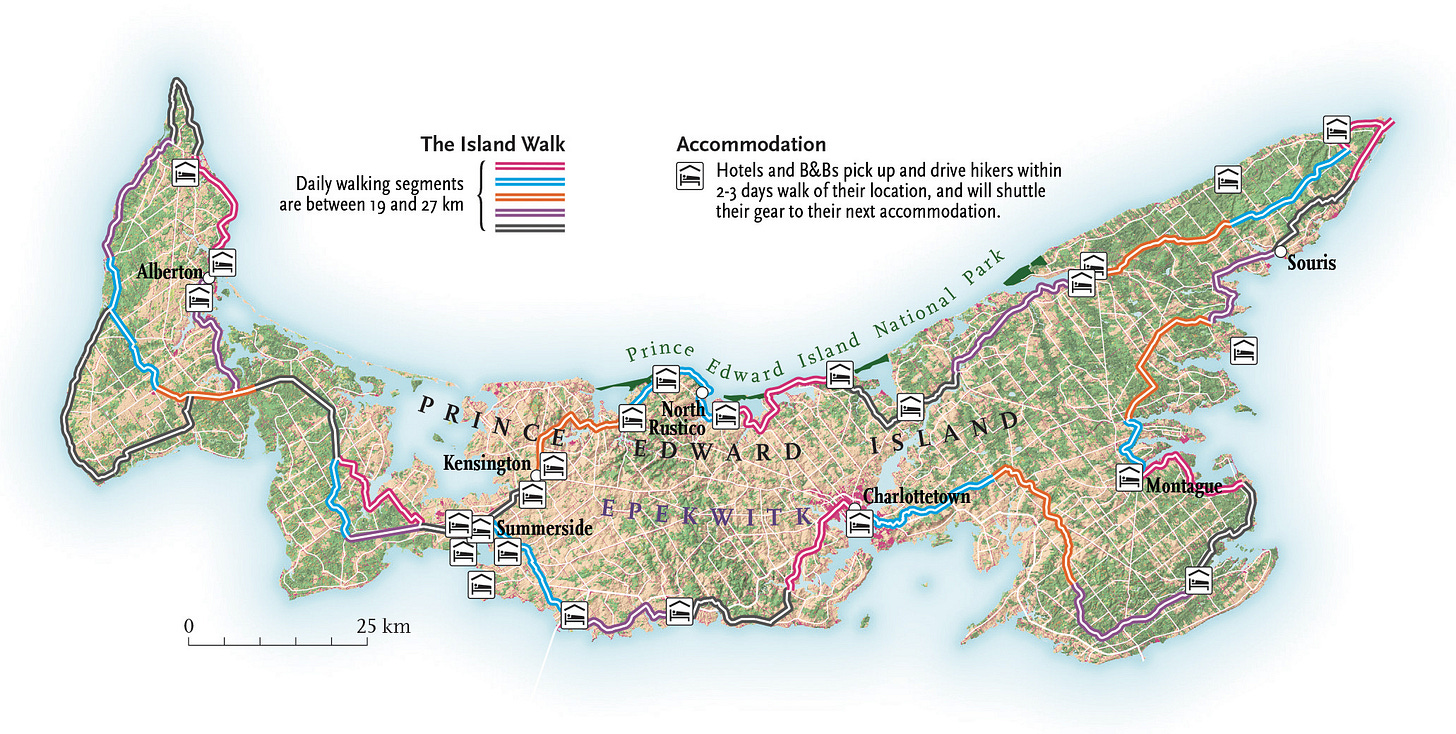
Great suggestions. The Rails to Trails network might provide additional routes for walking or cycling. Because the trails use abandoned train routes, the trails are easy walking. Another consideration is the Oregon Coast Trail- lots if small towns along the way.
Thanks for this post Blake! I had no idea there were so many “caminos” in spain! I agree with your friends that cycling is the American equivalent of a journey like this. About 15 years ago, I owned a bike shop in North Carolina. On a summer vacation, at a hot springs in Idaho, we met a guy doing the trans American ride and a few months later he showed up at the shop in NC! It was super cool.
Also, I think walking is viewed as just kind of “weird” in America, vs running or biking. You know, something you’d do for exercise. A friend who was an Ultra Runner once decided to walk across his home state of Michigan on rural roads mostly. One of his biggest observations was that at least once a day a driver would stop and ask if he needed a ride. This never happened when running. It did make me think.
Love your suggestions here and a great way to try out an adventure of a different sort !